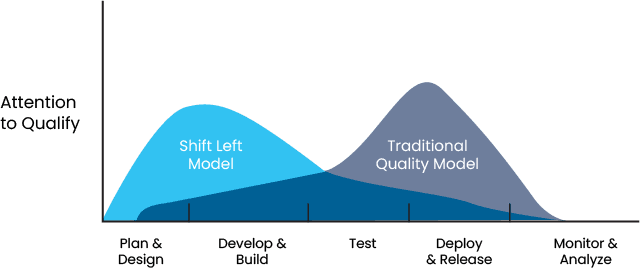- January 10, 2024
- Posted by: Srikanth Manoharan
- Category: Digital Assurance

Is testing keeping pace with the demands of modern IT? There is an ongoing need for real-time development, testing, and releases into production, and it’s imperative that Quality Assurance transitions from the legacy approach of testing at the end of a cycle or sprint to integrating quality through the entire development process to enable seamless and faster output.
As we evolve with the latest technology trends like AI and ML, IoT, Blockchain, Digital Twins, etc., the questions that come to mind are:
1. How do we keep pace with these changes while releasing software to the market with fewer bugs and improved quality?
2. How can we incorporate continuous testing and delivery?

SHIFT-LEFT TESTING
Indium’s TestOps team adopts a Shift Left approach to testing. The term ‘shift-left’ suggests a chronological progression to the left on the timeline of the SDLC, as indicated below. This approach aims to find and address defects as early as possible in the SDLC process, reducing the cost and impact of fixing issues later in the lifecycle.
In short, the mantra is to test early and often. With this approach, businesses can release new features faster, as testing is less likely to restrain development. However, according to a recent survey, 51% of businesses are at a disadvantage in responding to vulnerabilities because they use manual processes, leading to an insurmountable vulnerability backlog.
We simplify operations across the following key areas: Test Environment Deployment and Management, Validation, and Test Data Management and Monitoring. This ensures rapid release while reducing bugs by automating CI, QA, and continuous deployment (CD). Successful shift-left testing goes hand in hand with test automation. But how do we ensure continuous integration and continuous delivery (DevOps) with test automation?

TestOps entails a set of practices to ensure that products and services meet specific quality standards. This encompasses testing, monitoring, and analyzing the performance of systems and applications to identify and resolve any issues or bugs. The primary objective of TestOps is to guarantee that products and services are reliable, functional, and aligned with user needs. It plays a critical role in the software development, ensuring timely product delivery that fulfills customer requirements.
| DevOps | TestOps |
| Software deployable at any time to deliver business value across the value chain Focus: Release cycles with continuous deployment integrating Dev and IT Operations | Cultural Shift: A core role for Test as part of Operations Focus: Short Release cycles to achieve high-quality software with superior customer experience with the speed of continuous delivery |
We have a dedicated practice to streamline your Dev-Test-Ops cycle that maximizes operational efficiency with improved product quality and faster time to market!

Drawing upon decades of experience in digital assurance, I will delve into pivotal questions: the rationale behind automating testing in the DevOps lifecycle, selecting test cases and constructing automation flows, and the criteria for identifying the optimal DevOps software testing tool.
Automated Software Testing: The Glue Between Dev and Ops
A shift to a built-in quality mindset is essential to succeed in DevOps and maintain rapid software delivery. Collaboration, training automation engineers as testers, and recognizing the value of test automation are key. DevOps testing aligns seamlessly with agile and CI/CD, aiming for flexibility, velocity, and quick, high-quality releases. Automation speeds up the release pipeline, particularly in testing, reducing delays and errors. Automation, especially for tasks like regression testing, frees testers for higher-value, human-centric activities. The result is an optimized and efficient software delivery process.
Optimizing Test Cases and Enhancing DevOps Test Automation Workflows
As the EVP of Digital Assurance, delving into the practicalities of implementing test automation within our DevOps framework is both an exciting and strategic endeavor. To seamlessly integrate automated testing into our dynamic DevOps lifecycle, a meticulous approach to our release pipeline is paramount. Here’s a breakdown to guide us on this journey:
- Understanding Our Stages: We must comprehensively understand the key stages embedded in our release process. This foundational awareness will be a bedrock for the subsequent steps in our automation journey.
- Gate Check for Progression: Identifying crucial gates and delineating requirements are pivotal for ensuring fluid progression from the initial build to the final production stage. This strategic checkpoint will fortify the reliability and resilience of our release pipeline.
- Building a Feedback Loop: Establishing effective feedback mechanisms is key to swift error detection and resolution. As we craft our automation flows, integrating robust feedback loops will be instrumental in maintaining high software quality throughout the development lifecycle.
- Crafting an Operational Checklist: To streamline our release cycle, I propose compiling a detailed operational checklist encompassing all procedures, services, and actions. This checklist will serve as a comprehensive guide, ensuring that every aspect of our operations aligns seamlessly with our overarching automation goals.
How it works??
- DevOps Integration: QA Ops ensures seamless integration of DevOps by incorporating all necessary testing frameworks and tools into the product development lifecycle pipeline.
- Enhanced Test Planning: QA Ops provides a centralized platform, simplifying test planning for both testers and developers. It facilitates the identification of which tests to write and when to execute them.
- Test LifeCycle Management: The status of each Test significantly influences its treatment within build automation systems, such as CI/CD. This integration ensures a cohesive approach throughout the testing lifecycle.
- Test Version Control: Implementing processes that guarantee changes to tests undergo thorough review and approval, leveraging capabilities like pull requests in code. This ensures the reliability and stability of the testing process.
What transpires between these bookend phases?
The cornerstone is software testing, which is diverse in nature but vital in function. Integration tests ensure that modifications or new features are added without affecting the application. Usability testing uncovers previously unknown faults in code design, preventing problems from reaching end users. Device compatibility tests guarantee that the code works as intended in real-world scenarios, accounting for the complexities of numerous hardware and software factors.
This demonstrates why software tests serve as the glue that binds developers’ code to the production-level application maintained by TestOps engineers.
Our TestOps team build testing solutions that support and reinforce DevOps aims in order to properly incorporate software testing into a continuous delivery pipeline. When selecting a testing platform, we check for the following features:
- Support for an Array of Frameworks: Our evolving development demands may necessitate a testing solution that supports a wide range of frameworks, guaranteeing adaptability in our continuous delivery pipeline.
- Scalability: The platform for testing should scale effortlessly, performing tests as soon as possible, and supporting parallel tests to meet our evolving requirements. Cloud-based solutions offer the scalability required for our dynamic pipeline.
- Quick Testing: To prevent delays, tests must be performed swiftly. Utilizing large-scale parallel tests and prioritizing emulator and simulator compatibility testing can expedite the process.
- High Automation: The testing solution is at the heart of DevOps and should seamlessly integrate with our automated toolset, allowing triggered tests, automated result analysis, and information sharing amongst the organization.
- On Demand Testing: Performing tests whenever necessary is crucial. Cloud based testing provides a cost-efficient solution, avoiding the inefficiencies associated with maintaining an on-premises testing environment.
- Security: Security features within the testing platform, such as encrypted test data and robust access control, are paramount in ensuring the entire team, including testers, contribute to keeping our applications secure.
Incorporating these qualities into our testing strategy empowers our DevOps + QA teams to collaborate efficiently. This ensures the reliability and stability of our production code across environments, maximizing the scalability, visibility, agility, and continuity of our software delivery pipeline as we embrace the full potential of a DevOps-based workflow.




